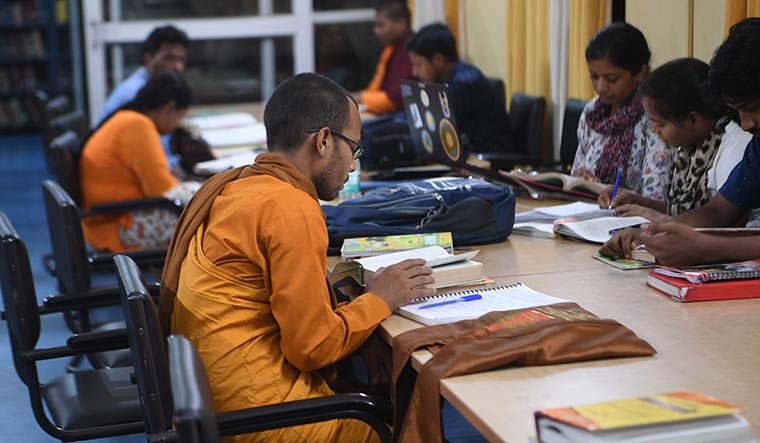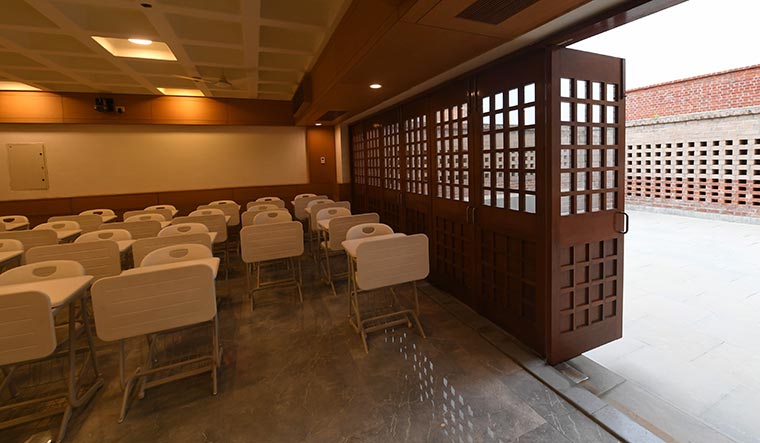It is a sweltering monsoon morning at Rajgir in Bihar’s Nalanda district. The overnight rain has made the air even more humid. THE WEEK’s Deputy Photo Editor Salil Bera and I are in a taxicab, dripping with sweat as we travel through the town. Our destination: the new, 455-acre campus of Nalanda University, a modern incarnation of India’s oldest university that now lies in ruins.
The new university is located a few kilometres away from the town―on a rocky, barren terrain overlooked by the Rajgir hills. Construction started in May 2017; work has been progressing steadily since.
We exit the cab near an imposing red building reminiscent of the old university. It is the main administrative block, which houses the office of the vice chancellor. Construction is complete; a tricolour flutters in the wind.
Inside, the air is comfortably cool. The building uses an innovative cooling technology called DEVAP, or desiccant-enhanced evaporative air-conditioning. DEVAP uses evaporative coolers and a drying agent (silica gel that comes in packets labelled “Do not eat”, for instance) to cool interiors. It is an eco-friendly and energy-efficient technology. Prof Sunaina Singh, the vice chancellor, says DEVAP has helped university buildings reduce energy consumption by 20 per cent.
Singh’s office is both grand and modern, with the university logo and idols of the Buddha prominently displayed. The floor space is dominated by a large workstation and conference table.
The Nalanda University was created by Parliament in November 2010. The idea of a modern university on the lines of the ancient one was first proposed at a summit of East Asian countries in 2007. The objective was to “advance the idea of an Asian community” and “act as a bridge for students in different parts of south Asia”. The university is under the external affairs ministry.
“Nalanda University aims to create a new workforce, a new think tank, a new human resource that will work towards building regional peace and harmony through the intellectual route,” says Singh.
The university started functioning in a temporary facility at Rajgir in September 2014. It was shifted to the new campus, located around 10km from the ruins of the old university, in January 2020. Apparently, 80 per cent of the construction is now complete.
From the administrative block, we travel two kilometres to the newly constructed auditorium. It has already hosted an international conference. The auditorium uses a mix of natural and ‘smart’ lights―the roof has shafts to let sunlight in, along with smart lights that can be controlled by cellphones. “The [smart] lights can be set according to the lux requirement (the brightness level needed), which in turn can be adjusted according to the natural light inside,” explains a supervisor. “This helps us save energy.”
A short walk from the auditorium is the guest house. It has 70 rooms, one of which vice president M. Venkiah Naidu stayed in when he visited the university last year to attend a conference.
Near the guest house is the academic block with modern classrooms. All rooms have adjustable, ergonomically designed chairs and tables, and a courtyard where students can rest between classes. Overlooking the corridor of the academic block are bottle-shaped structures―alcove-like spaces where students can hold discussions.
Perhaps the most impressive structure is the grand amphitheatre surrounded by a large waterbody. The amphitheatre can accommodate thousands of spectators. The waterbody is named Kamal Sagar, and it is meant to be a gigantic tank that harvests rainwater.
Waterbodies, big and small, now make up 40 hectares of the once-barren campus. Rainwater harvesting has been so efficient that the university does not need groundwater now. Kamal Sagar alone has water that can last for months, apparently.
The university has also been harnessing renewable energy in a big way. Solar and biomass plants satisfy part of its needs. Consumption is expected to go up once the residential blocks for students and the faculty are opened. The buildings are now mostly complete, and many students have already moved in. Nearby, a stadium is also receiving finishing touches.
“Eighty per cent of our students are from East Asian countries,” says Singh. “There are also a few students from Canada, Australia, New Zealand and even the US. The university offers MSc and PhD in ecology and environment studies, and also a course in historical studies that teaches historiography and archaeology. Then there is a programme on Buddhist studies, philosophy and comparative religion. Most of the students come and register for Buddhist studies. Last year, we started offering masters in Hindu studies; we also have masters in world literature.”
Singh says efforts are on to transform Nalanda University into a research base that links existing knowledge centres in member countries of the Association Southeast Asian Nations (ASEAN). It is already a nodal institution for AINU, or the ASEAN-India Network of Universities.
After touring Nalanda University, we go to the Nava Nalanda Mahavihara, deemed to be a university under the Union ministry of culture. The Mahavihara is just a stone’s throw from the Nalanda ruins. It is not as big as the Nalanda University campus, but it is teeming with students.
The Mahavihara was started in 1951 by a Buddhist monk called Jagdish Kashyap. “This university was a result of his vision and efforts,” says Prof Baidyanath Labh, the vice chancellor, pointing at a picture of the monk in his office.
According to Labh, Nalanda was the oldest centre of learning in the world. Apparently, it was called a mahavihara, which means a great monastic centre of learning. The term vishwa vidyalaya (university), which is now used to describe Nalanda, was not used in ancient times, says Labh.
“We are carrying the legacy of the old mahavihara that was established by Kumaragupta, emperor of the Gupta dynasty,” he says. “It was called Shri Nalanda Mahavihara, and it taught not just Buddhism and subjects related to it, but also vedas, mathematics, astronomy, medicine and metallurgy. Of course, the primary focus was on Buddhism, especially Mahayana Buddhism.”
The most authoritative document about the old university is a travelogue written by Hiuen Tsang, a Buddhist scholar-monk from China who visited Nalanda in the seventh century. “Hiuen Tsang studied in Nalanda for almost four years; it is also said that he taught for one year. On his return to China, he carried 657 manuscripts back with him,” says Labh.
A few kilometres from the campus of the Nava Nalanda Mahavihara is a memorial dedicated to Hiuen Tsang―a hall built in Chinese architectural style surrounded by lush trees. Inside is a statue of the great scholar, and the surrounding walls have paintings that chronicle his life and travels. “A museum and meditation hall are being planned next to the memorial. The meditation hall will accommodate around 200 people,” says Labh.
The Nava Nalanda Mahavihara has signed memorandums of understanding with universities in Thailand and Sri Lanka. Labh says the growing opportunities in history-related fields are driving a growth in the number of students. “Students in India mainly pursue degrees that will help them land jobs. Now, those who study history, culture and archaeology are also getting jobs―in the Archaeological Survey of India (ASI) and other academic domains. We are getting a good number of students from Pondicherry, Kerala and Maharashtra. Many students come from the Deccan College [Post-graduate and Research Institute] in Pune, which is considered India’s top college in archaeological studies.”
Malavika J. Babu, 23, of Kottayam in Kerala is pursuing MA in ancient history and archaeology at the Nava Nalanda Mahavihara. She says she had apprehensions about moving to Bihar for higher studies. “When I decided to pursue higher studies in Nalanda, my parents were concerned about my safety,” says Malavika. “But that changed. I have never felt unsafe here; in fact, I am highly impressed by Bihari hospitality.”
Tashigyalpo, a student from the Central Institute of Buddhist Studies in Leh, Ladakh, has started a six-month visit as part of his PhD programme. “I want to be near the place that is linked to the origin of Buddhism,” he says. “I regularly interact with the teachers and get interesting insights about Theravada and Mahayana Buddhism. I am trying to study linkages between Nalanda and Bodh Gaya.”
Nalanda’s rich historical connection with the Pali language, the sacred language of Theravada Buddhism, has also been attracting students from abroad. One of them is Aliya Boud of Laos, who is pursuing BA in Pali literature at the Nava Nalanda Mahavihara. “Many senior monks from our region in Laos studied here,” says Aliya. “Since the place is closely associated with the Buddha, I also wanted to study here.”
Nyarnadasand, a 32-year-old monk from Myanmar, is pursuing a PhD in Pali at the Mahavihara. He has been stuck in Nalanda since the pandemic began, and the political upheavals in his country have also not helped. “I want to go back, but it is taking time. Many monks from my country want to study in Nalanda, but are unable to do so because of the uncertainty there. I want to finish my PhD by 2024.”
According to Dhamma Jyoti, who teaches Pali at the Mahavihara, there is great interest in the language among students in southeast Asia. In fact, more than 60 per cent of Pali students are from southeast Asian countries.
“The political and economic problems in countries like Myanmar and Sri Lanka have prevented many students from studying here,” says Jyoti, who hails from Ladakh. “Also, many foreign students who went home during the pandemic have not returned. We are awaiting their arrival.”





